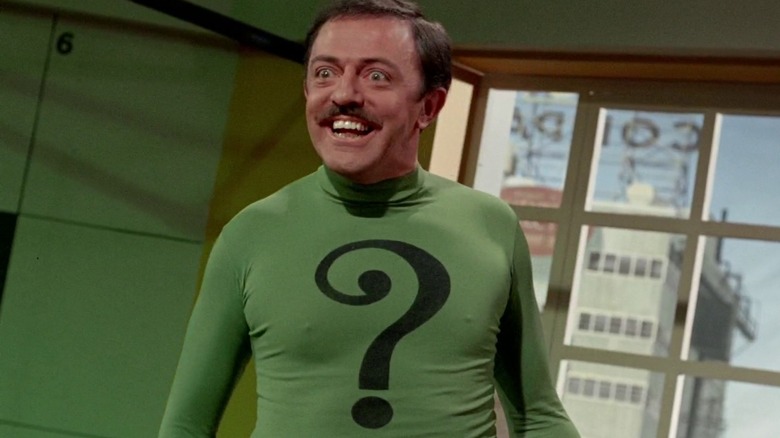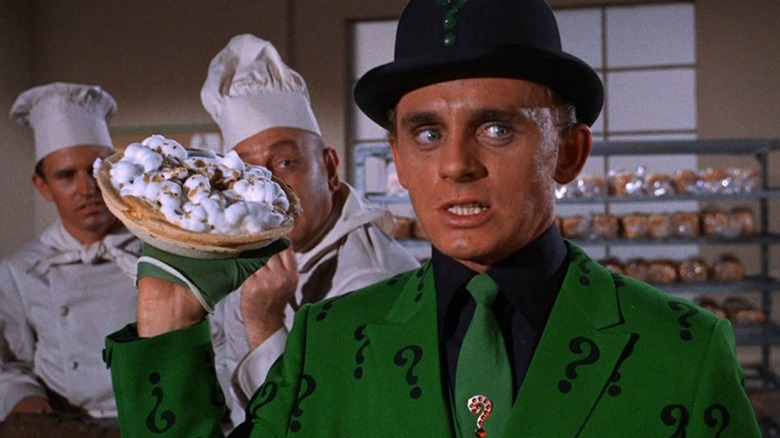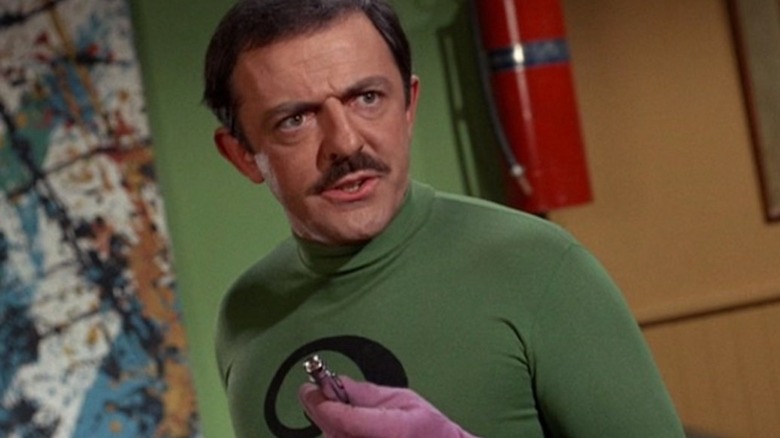Why John Astin Replaced Frank Gorshin As The 1966 Batman Series' Riddler
William Dozier's 1966 TV adaptation of "Batman" remains, even at this late date, the high water mark for all Batman media.
Colorful, whimsical, surreal, and borderline kinky, "Batman" served as an arch satire of the conservative underpinnings of most mainstream comic book heroes. Batman and Robin, played by the legendary Adam West and Burt Ward, were depicted as simultaneously heroic and terminally square, eschewing vice and indecency in favor of painfully wholesome, all-American activities such as camping, chess, drinking milk, birdwatching, and engaging in proper hygiene. Batman and Robin were walking 1950s classroom scare films, living in a bizarre universe of costumed vigilantes and horny criminals. The brilliance of the show came largely from West and Ward, who were able to deliver some of the strangest dialogue ever written without once ever winking or cracking a smile. "Batman" is a comedy masterpiece.
Of course, the most appealing aspect of "Batman" were its villains. CBS managed to hire a litany of notable stars and enthused actors to play the show's rotating bevvy of over-the-top antagonists. Cesar Romero played the Joker with infinite verve, Julie Newmar and Eartha Kitt played Catwoman with Lee Meriwether stepping in for the 1966 movie, each one of them bringing their own snarling glee to the role. Burgess Meredith played the Penguin as the sexiest mother****** alive. These were in addition to notable stars like Victor Buono, Vincent Price, Anne Baxter, Shelley Winters, Roddy McDowell, Milton Berle, Tallulah Bankhead, and Liberace.
Comedy genius Frank Gorshin played the role of the Riddler in five episodes and in the 1966 film, always cackling with overcaffeinated joy. Fans, however, might note that Gorshin did not appear in the show's second season. It seems that Gorshin wanted more money, and the studio refused.
Gorshin's salary
Gorshin knew that he was important to "Batman." He was, after all, one of four villains asked to appear in the "Batman" feature film. According to a 2011 post on the Martin Grams Batman blog, Gorshin had switched agents early in 1966, and the new agency, William Morris, asked that Gorshin's salary be doubled for the second season. Skipping from $2,500/episode to $5,000 was more than Dozier could handle, and he even felt a little miffed that Gorshin (or his agents) should be so demanding. Dozier write a — somewhat condescending — letter to Gorshin, saying that the actor's overall exposure that came from playing the Riddler, and the additional acting opportunities it could potentially afford, should be reward enough. Note that $5,000 was indeed a lot of money. An acverage "Batman" episode only cost about $200,000 to make. The entire series only ran a price tag of about $3.3 million.
Gorshin's demand for more, however, wasn't just the actor's ego talking. He did receive an Emmy nomination for his performance. He was a known quantity. The actor demanded more, Dozier balked, Gorshin walked.
By the time Gorshin quit, however, the "Batman" shooting schedule was already in place. In December of 1966, a two-part, second-season episode of "Batman" that had originally been written for the Riddler had to repurposed. A very similar villain called the Puzzler was invented for the occasion, with the stalwart Maurice Evans stepping in. This would be the only time the Puzzler was to appear on the show.
Dozier, luckily, had a recently canceled sitcom he would be able to mine for a potential replacement.
Neat, sweet, petite
"Batman" first began airing in January of 1966. This was bad news for the its rival, the macabre sitcom "The Addams Family," starring John Astin and Carolyn Jones. According to Astin, "Batman" siphoned off a great deal of his "Addams" audience, leading directly to the show's cancelation the following April. The "Addams" cast was upset, of course, but also understood that "Batman" was constantly on the lookout for interesting and notable actors to play its villains.
In a November episode of "Batman," Jones appeared as the avaricious villainess Marsha, Queen of Diamonds, a criminal who aimed to marry Batman. Jones would return to play Marsha in a three-part episode in the show's third season, wherein she teamed up with the Penguin. In December of 1966, in the episode "The Penguin's Nest," Ted Cassidy, who played the cadaverous butler Lurch on "The Addams Family" would appear in a cameo. When Batman and Robin climbed up the sides of buildings, they would frequently run into notable celebrities who peeked out of their windows to say hello. Cassidy, as Lurch, was one of such cameos.
The Riddler would eventually return, and John Astin was selected to fill in the role for a second season episode in 1967. Astin, while not as hyperkinetic as Gorshin, brought an intense, weird sensuality to the part, as was clearly having a great time. Dozier would eventually agree to pay Gorshin's demands, however, and Gorshin's version of the Riddler would come back for one final episode in the show's third season.
Shifting actors happened a lot on "Batman," however, so few fans were upset. Apart from the three Catwomen, George Sanders, Otto Preminger, and Eli Wallach all played Mr. Freeze. It was, it seems, just another wacky detail of a brilliant, wacky show.


